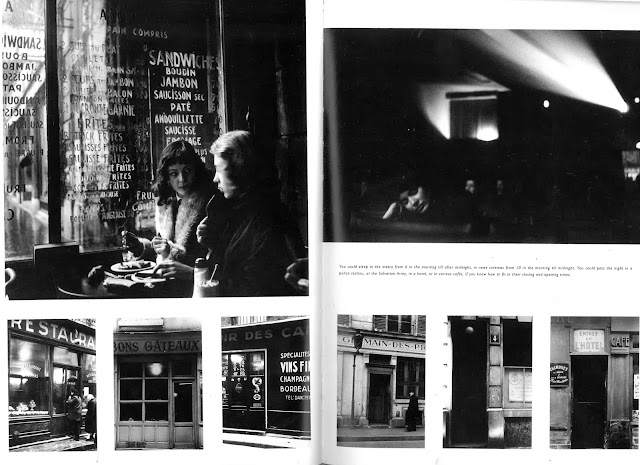I have decided to look at the work of American street photographer Garry Winogrand, after coming across his book Public Relations in the library the other day. Which after reading more about the series and Winogrand's other work, has given me plenty of inspiration for my ideas with the relationship project.
 |
| New York, 1969 |
Winogrand created his street photographs across America using his characteristic 28mm lens. Because of this he had to get very close to the often reluctant subjects he was photographing. For example in the image above taken in New York of the couple and the girl walking past, we see that the two women both are very aware of Winogrand and although there is a tough feeling to this photograph it evokes a gentle sense of curiosity. Winogrand's images often capture the very instant that his subject's notice him, and they often leave you wanting to know what happened after these moments where the subjects registered his presence.
What interests me about this approach is the way Winogrand made himself part of his images to get a reaction from his subjects. This to me is similar to the methods of Arbus and Gilden , although there is something less aggressive about Winogrand's approach. I read that Diane Arbus described Winogrand as "an instinctive, nearly primitive ironist, so totally without mailce, so unflinching, even cheerful". This to me reveals that Winogrand's interaction with his subjects was more to do with an elation he felt in catching people in this way, rather than trying to provoke people to the extent that Gilden and Arbus would have done for their more gritty images.
 |
| Central Park Zoo, New York, 1967 |
As Arbus mentioned his work was very much about irony, in terms of capturing people in ways we wouldn't expect to see them. In the photograph above for example with the interracial couple holding chimpanzees, no one would have expected to see this couple at this time choosing to confront and parody the racist antagonism they would have received towards their relationship. The framing I think is particularly clever in this with the inclusion of this boy in the bottom right corner, who looks similarly as anxious as the two chimpanzees dressed up like humans.
In 1969 Winogrand was awarded his second Guggenheim Fellowship to photograph "the effect of the media on events". He assumed that this was referring to what Daniel J. Boorstin described as "pseudo-events" in his book "The Image: A Guide to Pseudo-events in America". Which discusses the role of media events in American society and the hyperreality of events existing purely for publicity. Winogrand later named this series Public Relations which went on to be exhibited at MoMa in 1977.
In this series of images by Winogrand he uses his wide lens to capture how organisations and famous people maintain their public image for mass media. He did this by photographing election campaigns, press conferences, museum openings, receptions, protests and strikes. Depicting all aspects of these public and private events designed to be documented.
In this series of images by Winogrand he uses his wide lens to capture how organisations and famous people maintain their public image for mass media. He did this by photographing election campaigns, press conferences, museum openings, receptions, protests and strikes. Depicting all aspects of these public and private events designed to be documented.
The more technical elements of this series really interests me as compositionally his use of a wider lens and tilting the frame creates a really intriguing style that I think says something more about his subject matter. The tilting of the frame for example, that slants walls and tilts the smiling attendees of these events I think communicates how these pseudo-events lack a certain amount of reality. As they are incredibly one sided in existing solely for the purposes of presenting an image to the media. These wider shots also have individual impact as more is able to fill the frame and therefore an event can often be summed up by Winogrand in one image.
Above one of my favourite photographs from the series that I came across in the book of Public Relations by Winogrand. What I like so much about it is this alternative perspective it gives of a press conference, as normally the photographs we see from conferences are of the people answering the questions. There is also a very strange dynamic in this scene as there is this energetic seeming woman asking a question who is surrounded by lacklustre people; many of whom despite looking at her don't appear to be listening to her.
I also think there is something intriguing about this scene as although we know the context of this press conference (Nation Book Awards), it appears to be in a very grand place yet there is such a lifeless energy in this room. Which is added to by the number of empty seats that Winogrand has included in the frame, rather than taking the shot closer to the people to make the event seem more popular or successful.
What interests me so much about Public Relations is the variety of social dynamics that Winogrand was able to explore through capturing these events. It has left me feeling very interested in the ways that we come together in acts that allow our society to celebrate itself.
The events that Winogrand was able to capture in the late 60s and early 70s I feel no longer exist in the same way today or have quite the same narrative potential nowadays. However I feel as though this is something I should think about more and explore with my work, particularly in regards to other hyperrealities that exist in today's society. The effects of social media on relationships comes to mind. However I feel as though I would need to find a very unique way to approach that subject matter.
































